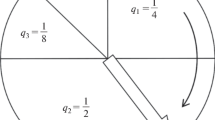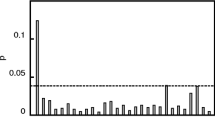Abstract
We study an algorithm which allows sequences of binary numbers (strings) to interact with each other. The simplest system of this kind with a population of 4-bit sequences is considered here. Previously proposed folding methods are used to generate alternative two-dimensional forms of the binary sequences. The interaction of two-dimensional and one-dimensional forms of strings is simulated in a serial computer. The reaction network for the N = 4 system is established. Development of string populations initially generated randomly is observed. Nonlinear rate equations are proposed which provide a model for this simplest system.
Similar content being viewed by others
References
Banzhaf W (1993a) Self-replicating sequences of binary numbers. Foundations I: General. Biol Cybern 69:269–274
Banzhaf W (1993b) Self-replicating sequences of binary numbers. III. Larger systems
Banzhaf W (1993c) Self-replicating sequences of binary numbers. Comp Math (in press)
Banzhaf W (1993d) Self-replicating binary strings: the buildup of complexity. Complex Syst (submitted)
Cech TR, Bass BL (1986) Biological catalysis by RNA. Annu Rev Biochem 55:599–629
Eigen M, Schuster P (1977) The hypercycle: a principle of natural self-organization, part A. Naturwissenschaften 64:541–565
Eigen M, Schuster P (1978a) The hypercycle: a principle of natural self-organization, part B. Naturwissenschaften 65:7–41
Eigen M, Schuster P (1978b) The hypercycle: a principle of natural self-organization, part C. Naturwissenschaften 65:341–369
Fraunfelder H (1988) Biomolecules. In: Pines D (ed) Emerging synthesis in science. (SFI studies in the sciences of complexity, vol 1). Addison-Wesley, Reading, Mass
Gillespie DT, Mangel M (1981) Conditioned averages in chemical kinetics. J Chem Phys 75:704–709
Guerrier-Takada C, Gardiner K, Marsh T, Pace N, Altman S (1983) The RNA moiety of ribonuclease P is the catalytic subunit of the enzyme. Cell 35:849–857
Haken H (1983) Synergetics. An Introduction. Springer, Berlin
Kauffman S (1986) Autocatalytic sets of proteins. J Theor Biol 119:1–24
Kruger K, Grabowski PJ, Zaug AJ, Sands J, Gottschling DE, Cech TR (1982) Self-splicing RNA: autoexcision and autocyclization of the ribosomal RNA intervening sequence of Tetrahymena. Cell 31:147–157
Author information
Authors and Affiliations
Additional information
Dedicated to Professor Hermann Haken on the occasion of his 65th Birthday
Rights and permissions
About this article
Cite this article
Banzhaf, W. Self-replicating sequences of binary numbers. Foundations II: Strings of length N=4. Biol. Cybern. 69, 275–281 (1993). https://doi.org/10.1007/BF00203124
Received:
Accepted:
Issue Date:
DOI: https://doi.org/10.1007/BF00203124




